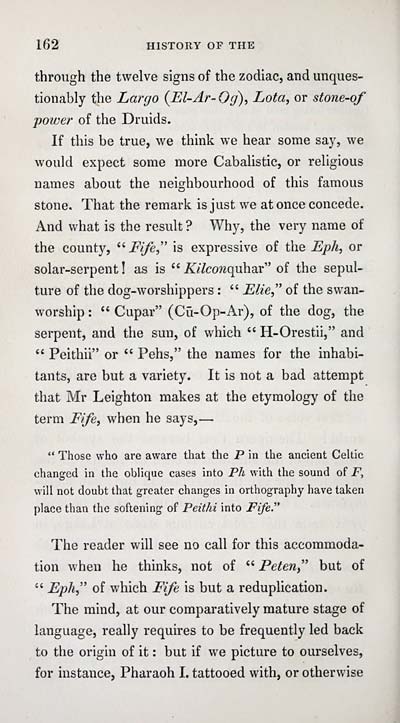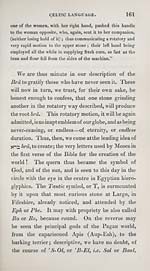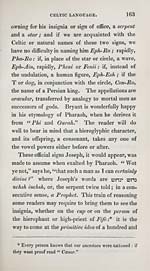Download files
Complete book:
Individual page:
Thumbnail gallery: Grid view | List view

162 HISTORY OF THE
through the twelve signs of the zodiae, and unques-
tionably the Largo {El-Ar-Og), Lota, or stone-of
power of the Druids.
If this be true, we think we hear some say, we
would expect some more CabaUstic, or reUgious
names about the neìghbourhood of this famous
stone. That the remark is just we atonceconcede.
And what is the result ? Why, the very narae of
the county, ^^- Fife" is expressive of the Eph, or
solar-serpent ! as is " Kilcon^n)\ax" of the sepul-
ture of the dog-worshippers : " Elie," of the swan-
worship : " Cupar" (Cii-Op-Ar), of the dog, the
serpent, and the sun, of which " H-Orestii," and
" Peithii" or " Pehs," the names for the inhabi-
tants, are but a variety. It is not a bad attempt
that Mr Leighton makes at the etymology of the
term Fife, when he says, —
" Thosc who are aware that the P in the ancient Celtic
changed in the oljlique cases into Ph with the sound of F,
will not doubt that greater changes in orthography have taken
place than the softening of Peithi into Fife."
The reader wiU see no caU for this accommoda-
tion when he thinks, not of " Peten" but of
" Eph," of which Fife is but a redupUcation.
The mind, at our comparatively mature stage of
language, reaUy requires to be frequently led back
to the origin of it : but if we picture to ourselves,
for instance, Pharaoh I. tattooed with, or otherwise
through the twelve signs of the zodiae, and unques-
tionably the Largo {El-Ar-Og), Lota, or stone-of
power of the Druids.
If this be true, we think we hear some say, we
would expect some more CabaUstic, or reUgious
names about the neìghbourhood of this famous
stone. That the remark is just we atonceconcede.
And what is the result ? Why, the very narae of
the county, ^^- Fife" is expressive of the Eph, or
solar-serpent ! as is " Kilcon^n)\ax" of the sepul-
ture of the dog-worshippers : " Elie," of the swan-
worship : " Cupar" (Cii-Op-Ar), of the dog, the
serpent, and the sun, of which " H-Orestii," and
" Peithii" or " Pehs," the names for the inhabi-
tants, are but a variety. It is not a bad attempt
that Mr Leighton makes at the etymology of the
term Fife, when he says, —
" Thosc who are aware that the P in the ancient Celtic
changed in the oljlique cases into Ph with the sound of F,
will not doubt that greater changes in orthography have taken
place than the softening of Peithi into Fife."
The reader wiU see no caU for this accommoda-
tion when he thinks, not of " Peten" but of
" Eph," of which Fife is but a redupUcation.
The mind, at our comparatively mature stage of
language, reaUy requires to be frequently led back
to the origin of it : but if we picture to ourselves,
for instance, Pharaoh I. tattooed with, or otherwise
Set display mode to: Large image | Transcription
Images and transcriptions on this page, including medium image downloads, may be used under the Creative Commons Attribution 4.0 International Licence unless otherwise stated. ![]()
| Early Gaelic Book Collections > Hew Morrison Collection > Adhamh agus Eubh, no Craobh Sheanachais nan Gàël > (292) |
|---|
| Permanent URL | https://digital.nls.uk/76900254 |
|---|
| Description | A selection of items from a collection of 320 volumes and 30 pamphlets of literary and religious works in Scottish Gaelic. From the personal library of Hew Morrison, the first City Librarian of Edinburgh. |
|---|
| Description | Selected items from five 'Special and Named Printed Collections'. Includes books in Gaelic and other Celtic languages, works about the Gaels, their languages, literature, culture and history. |
|---|

